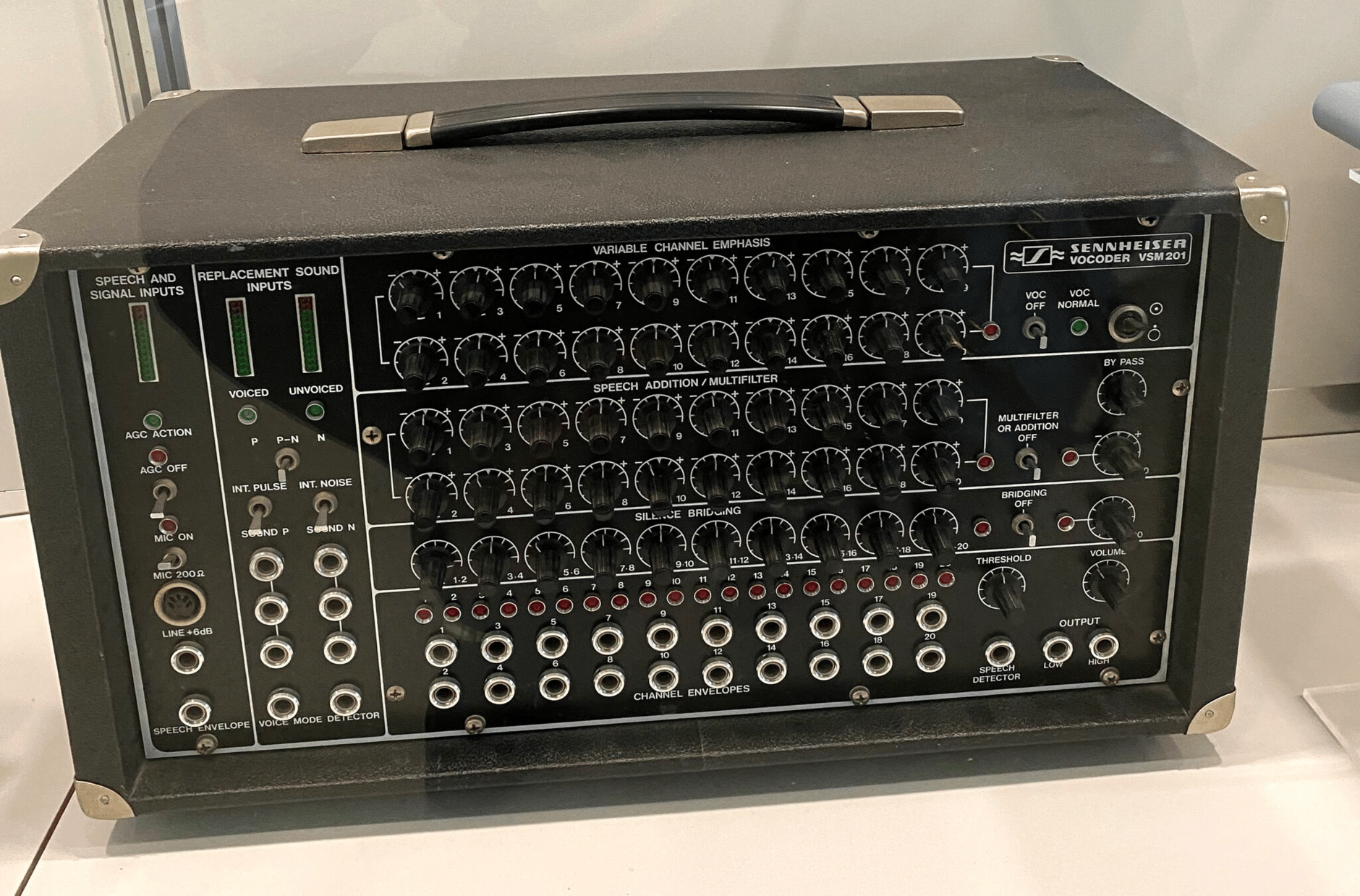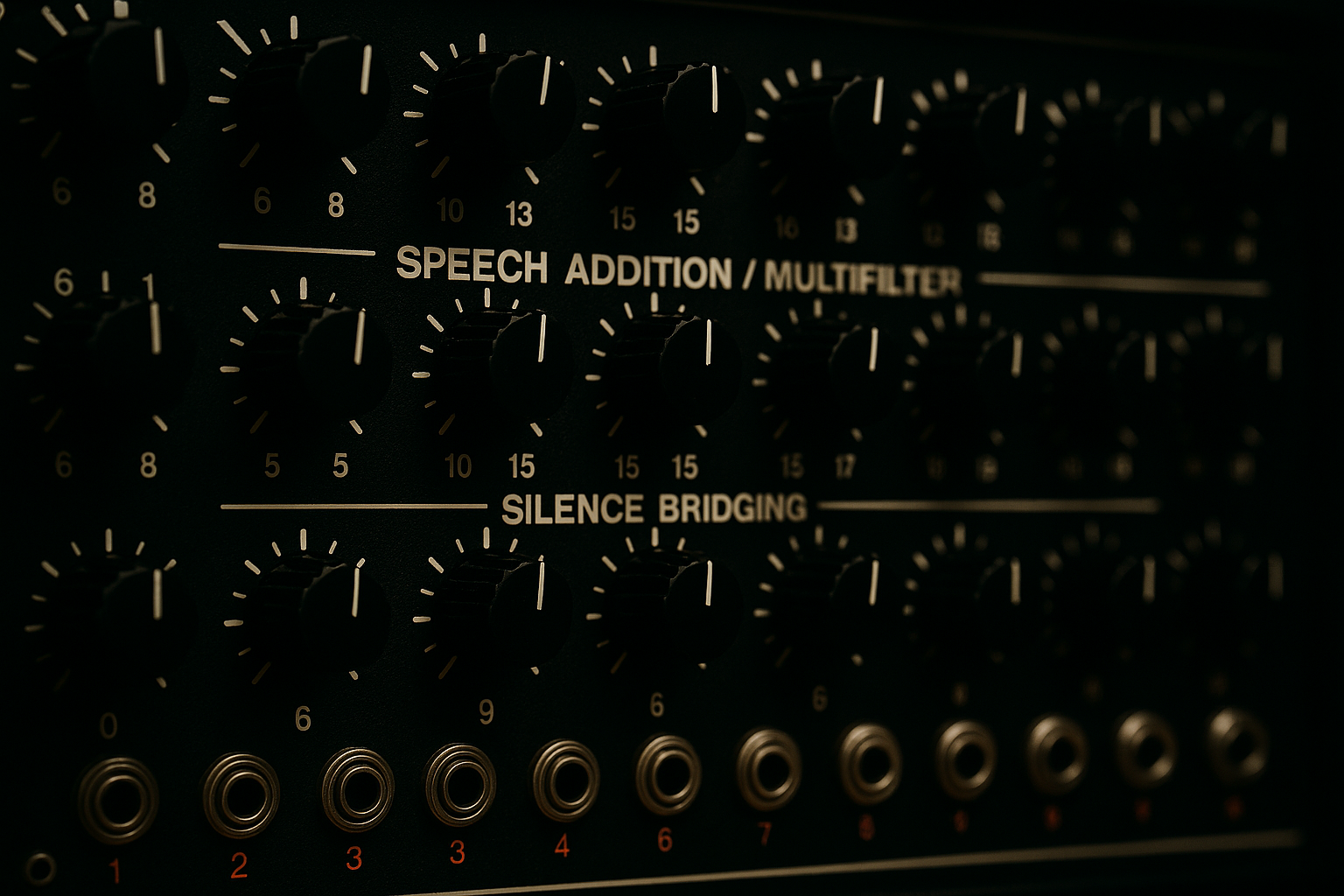What Is a Vocoder?
A vocoder (short for “voice encoder”) is a device that analyzes and synthesizes the human voice signal for audio effects or data transmission. It works by splitting a voice (modulator) into frequency bands and using those envelopes to shape another sound (carrier), resulting in robotic, harmonized speech — a sound made famous by Kraftwerk, Daft Punk, and Jean-Michel Jarre.
But before it became a musical tool, the vocoder was a military invention, used to encrypt speech during wartime communications.
Sennheiser’s Secret History with Vocoders
The VSM 201 isn’t just a musical instrument — it’s a relic of classified technology. During WWII, Fritz Sennheiser conducted research on speech modulation and encryption. After the war, Germany was banned from continuing this work, but once it joined NATO in the 1950s, Sennheiser resumed development, producing vocoders for government agencies.
The VOCC 490, part of the Elcrovox encryption system, is now on display at the Frankfurt Museum of Telecommunications. Its design directly influenced the VSM 201, which was later adapted for musical use in the late 1970s.
The VSM 201: A Rare and Expensive Prototype
According to Sennheiser engineers, only around 50 units of the VSM 201 were ever produced. It was prohibitively expensive and technically complex, which limited its commercial success. Still, it found its way into the hands of legendary artists like Jean-Michel Jarre and Kraftwerk.
Hainbach’s video reveals that the unit he explored was a prototype, partially cannibalized for parts to repair another model. Despite its age and missing components, the vocoder still functions — albeit with a persistent hum due to lack of shielding.
Hands-On with the VSM 201
In the video, Hainbach walks through the vocoder’s features:
· Speech and signal inputs for modulating external audio.
· Internal pulse modulation and noise shaping.
· Envelope outputs for modular synth integration.
· Variable channel emphasis for fine-tuning frequency bands.
· Filter bank bypass for clean signal mixing.
Despite technical challenges, Hainbach manages to coax expressive, intelligible sounds from the unit — even creating a custom sampler instrument from its output.
From Encryption to Expression
The VSM 201 is a perfect example of “swords to plowshares” — a technology born from secrecy and security, repurposed for creativity and culture. Its legacy lives on not just in music, but in the very idea that sound can be shaped, encoded, and reimagined.
Why This Matters for Creators Today
With the rise of modular synthesis, AI-generated music, and experimental sound design, the vocoder is more relevant than ever. Sennheiser’s legacy in this space offers inspiration and technical insight for creators pushing the boundaries of audio.
Legacy in Popular Music
The VSM 201 vocoder has left a subtle yet powerful imprint on the sound of electronic music. Artists like Kraftwerk used vocoders to create their signature robotic vocals, which became a hallmark of their futuristic aesthetic. Jean-Michel Jarre incorporated vocoded speech into his ambient compositions, adding a layer of technological mystique. These artists helped popularize the vocoder as a musical tool, transforming it from a niche device into a staple of electronic production.
Technical Innovations of the VSM 201
What sets the VSM 201 apart from other vocoders is its modular design and emphasis on control voltage outputs. This allowed users to integrate the vocoder into larger modular synth setups, triggering sequencers or modulating oscillators based on vocal input. Its variable channel emphasis and filter bank bypass features gave musicians unprecedented control over the tonal shaping of their sound. Even today, these features are considered advanced, making the VSM 201 a forward-thinking instrument for its time.
Modern Relevance and Revival
In recent years, there has been a resurgence of interest in vintage audio gear, especially among modular synth enthusiasts and experimental musicians. The VSM 201, with its rich history and unique sound, has become a sought-after piece of gear for collectors and creators alike. Its connection to encryption technology also resonates in today’s world, where data privacy and secure communication are hot topics. By revisiting the VSM 201, artists are not only embracing analog warmth but also exploring the intersection of sound and security.
Sennheiser’s Role in Audio Innovation
Sennheiser has long been a pioneer in audio technology, from microphones and headphones to wireless systems and studio monitors. The VSM 201 vocoder is a testament to the brand’s willingness to experiment and push boundaries. By supporting creators like Hainbach and opening their archives, Sennheiser continues to foster innovation and preserve audio heritage. This commitment to both legacy and progress is what makes Sennheiser a trusted name among professionals and enthusiasts.
Conclusion
The VSM 201 vocoder is more than a piece of vintage gear — it’s a bridge between eras, technologies, and artistic visions. Its story, as told by Hainbach, invites us to reflect on how sound can be used to communicate, encrypt, and inspire. As we celebrate Sennheiser’s 80th anniversary, the vocoder stands as a symbol of the brand’s enduring impact on audio culture.



